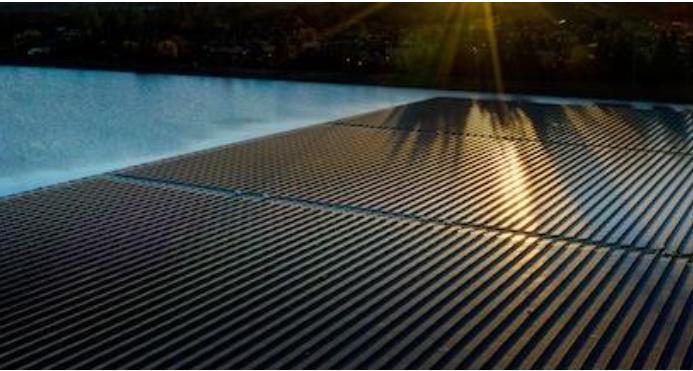-
https://climateinstitute.bmo.com/static/images/clock-icon.svg
5 Minute Read
-
Listen
-
Stop
-
Text Bigger | Smaller
On a pond in California's wine country, an expanse of nearly 5,000 solar panels powers the small Town of Windsor's water treatment facility. The floating array produces 1.8 megawatts of electricity, which meets 90 percent of the facility's power needs. It also enables the town to control its energy costs, spending just 30 percent of its previous electricity bill.
This success story isn't a one-off, feel-good local story for those of us in the Bay Area. Solar projects like Windsor's are becoming more common across the globe, as the world adds solar capacity at a rate equivalent to over a gigawatt per day.1 Driven by regions like my home state of California, New Jersey and Florida, where high energy demand and land values create pressure for alternative solutions, U.S. floating solar is set to expand at around 13 percent annually.2
The proliferation of these projects showcases something I've been thinking about a lot lately: When sustainably minded public entities build partnerships with innovators in the private sector, they're able to effectively create both environmental and economic benefits.
High expectations for solar capacity growth
Right next door to Windsor, in Healdsburg, Calif., floats a similar array more than double the size of Windsor's. The two installations are among hundreds of solar power plants operating in California, the largest producer of solar energy in the United States. California currently boasts an installed capacity of almost 32,000 megawatts, including distributed systems.3 As a new state law decrees that large companies in California must disclose their emissions, local demand for solar energy and other innovative renewable energy solutions will continue to rise.
Globally, solar photovoltaic capacity is expected to grow 13-fold by 2050.4 Despite inflation, utility-scale solar costs continue to fall, as does the price of power generated by solar, suggesting we may be approaching a tipping point.5,6 And here in the United States, we're getting an additional $144 billion boost for solar investment from the Inflation Reduction Act, putting the federal government's total expected investment to more than $565 billion over the next decade.7
Teaming up with a solar innovator
To bring the Windsor array to life, the town joined forces with Ciel & Terre, a customer of legacy Bank of the West, which is now part of BMO.
Headquartered in France, this solar innovator recently designed and engineered North America's largest floating solar project, on Canoe Brook Reservoir, New Jersey.8 Ciel & Terre has built more than 290 floating solar farms in over 30 countries across the globe and currently has 1.6 gigawatts of floating solar capacity in the pipeline.

Ciel & Terre's waterborne designs have several advantages:
-
The water keeps solar arrays cool so that they generate more power than land-based systems.
-
LEGO-like configurations make them easy to assemble and expand.
-
The panels are resilient enough to withstand wind, rain and snow.
-
The arrays can slash evaporation from the water they float on, control algae growth and reduce pond bank erosion.
As California targets 100 percent zero-carbon electricity by 2045 and land values remain high, demand for Ciel & Terre's services is only set to grow.
A young sector, expanding fast
The Town of Windsor has taken action to lower its greenhouse gas emissions across a broad spectrum of activities. Other California towns, facing increasingly volatile weather and wildfires, as well as a statewide carbon neutrality target by 2045, are acting too.
In Windsor, the shift to solar has helped the town meet its sustainability goals. Before the new system, the water treatment plant accounted for nearly 40 percent of the town's greenhouse gas emissions. Today, the array provides not only 90 percent of the electricity for wastewater treatment but 90 percent of the electricity needed for a pumping station, the public works administration building and the public works corporation yard.9

Floating solar made up less than 1 percent of total worldwide solar installations in 2022 and has yet to make inroads into Canada.10 But the sector has grown by more than 2,000 percent in the last decade, and Ciel & Terre has big goals for expansion. Critical factors for scaling their innovation include partners with global reach, shared values and market-specific expertise.
These plans for growth come at an apt time. Driven by high fossil fuel prices and a desire for energy security as well as the climate crisis, global renewable energy capacity is projected to grow by almost 75 percent between 2022 and 2027.11 The International Energy Agency's estimate is revised up by close to 30 percent from the previous forecast because the United States, China, India and Europe are changing course much faster than anticipated. And solar is leading that charge. The United States saw a 44 percent year-on-year increase in solar energy during the first quarter of this year; Canadian solar grew by over 25 percent last year.12, 13
As climate change becomes a higher priority for countries, regions and municipalities worldwide, floating solar can deliver an affordable source of renewable energy without competing for land. Here in California, we deeply feel that tension between finding acreage for renewables that might otherwise be leveraged for agriculture, conservation or other uses — and I know many other areas around the globe feel it too. That’s why, for solar innovators like Ciel & Terre, and for renewable energy partnerships across communities and the commercial sector, the future looks bright.
Footnotes:
1. Jenny Chase, 3Q 2023 Global PV Market Outlook, BloombergNEF, September 2023.
2. Wood Mackenzie, Global floating solar to top 6GW threshold by 2031, May 2023.
3. U.S. Energy Information Administration, California State Profile and Energy Estimates, April 2023.
4. DNV, Energy Transition Outlook 2023, October 2023.
5. Lawrence Berkeley National Laboratory, Utility-Scale Solar, 2023 Edition, October 2023.
6. International Renewable Energy Agency, Renewable Power Generation Costs in 2022, August 2023.
7. Solar Energy Industries Association, Impact of the Inflation Reduction Act, accessed October 2023.
8. PBS, Short Hills reservoir has largest floating solar array in US, June 2023.
9. Rhea R. Borja, Windsor builds one of the nation's biggest floating solar arrays, Western City, April 2022.
10. Jonathan Tirone, Floating Solar Panels Turn Old Industrial Sites Into Green Energy Goldmines, Financial Post, August 2023.
11. IEA, Renewable electricity, accessed October 2023.
12. National Renewable Energy Laboratory, Summer 2023 Solar Industry Update, August 2023.
13. Canadian Renewable Energy Association, Canada added 1.8 GW of wind and solar in 2022, January 2023.
Featured Publications

Many corporate leaders in Canada and the U.S. have been creating climate mitigation plans to addres…

It might seem obvious to say that the energy transition will require a lot of innovation to happen.…

In the latest episode of Sustainability Leaders, I sit down to discuss growing water-related busine…





